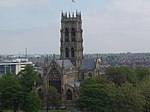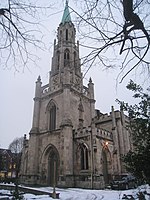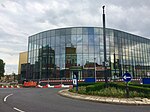Doncaster Rural District
History of South YorkshirePolitics of DoncasterRural districts of the West Riding of YorkshireUse British English from January 2019
Doncaster was a rural district in the West Riding of Yorkshire, England from 1894 to 1974. The rural district was created by the Local Government Act 1894 as successor to the Doncaster Rural Sanitary District. It consisted of an area surrounding, but not including, the town of Doncaster. Doncaster itself formed a separate municipal borough (from 1927 a county borough). The district underwent a number of boundary changes over its existence due to the expansion of Doncaster and the growth of a number of other towns.Doncaster Rural District Council were granted armorial bearings on 30 October 1947.
Excerpt from the Wikipedia article Doncaster Rural District (License: CC BY-SA 3.0, Authors).Doncaster Rural District
Prince's Street, Doncaster Hyde Park
Geographical coordinates (GPS) Address Nearby Places Show on map
Geographical coordinates (GPS)
| Latitude | Longitude |
|---|---|
| N 53.5225 ° | E -1.1286111111111 ° |
Address
Iceland
Prince's Street
DN1 3NJ Doncaster, Hyde Park
England, United Kingdom
Open on Google Maps








